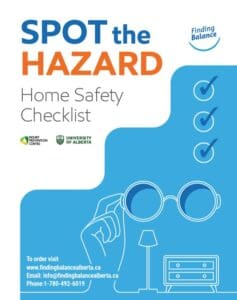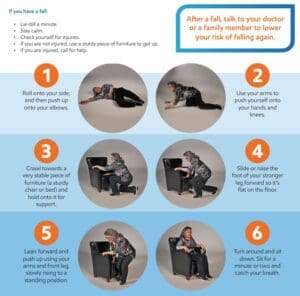Fall is a leading public health issue across age groups and settings in Alberta. According to AHS, in 2022, 154,004 Albertans visited emergency and urgent care and 17,489 Albertans were hospitalized due to a fall. Falls can happen at home, at school, in recreation and leisure, in sports, in the community, at work and even on vacation.
We collected some resources for preventing falls. We hope you find them useful
Falls Prevention Month – November 2025
November is Falls Prevention Month, a reminder that while our bodies naturally change as we age, falls don’t have to be part of getting older. In fact, most falls are preventable with the right knowledge, habits, and environment.
Take actions today!
Check out the Spot the Hazard Home Safety Checklist!
A fall can have a significant impact on the lifestyle and independence of an older adult. Falls are the leading cause of injury among seniors in Alberta. Every year 1 in 3 older Albertans will fall.
The Spot the Hazard Home Safety Checklist guides you to:
- Identify hidden hazards in your home
- Prevent falls and injuries
- Maintain your independence
Use this checklist as a guide to spot hazards in your home that may increase your risk of falling. Many of these hazards are often overlooked but important to fix.
KEEPING WELL for older adults
Keeping Well for Older Adults is a practical and easy-to-follow guide designed to help seniors stay healthy, active, and safe at home and in the community. The booklet covers a wide range of topics — from physical and mental well-being to home safety, healthy eating, medication awareness, and fraud prevention. It also includes step-by-step exercise routines to build strength and balance, tips for safe walking in winter, and checklists to support daily wellness. With helpful contacts, puzzles, and a falls prevention calendar, this resource empowers older adults to live independently and confidently.
Keeping Well for Older Adults was created to help older Albertans keep well, active and connected to lower their risk of falling.
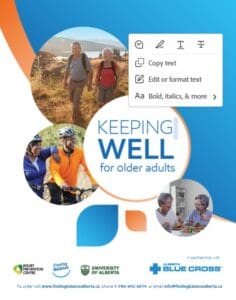
Vision & Falls
Clear vision is critical to preventing falls. Ensuring your eyeglass prescription is correct is a good first step in fall prevention, but your eye health is equally important. Alberta Health coverage is available towards your annual eye exam for Albertans 65+
There is no better time to focus on quality vision care to preserve your eye health, an active independent life, and the chance to enjoy all that you love! Your optometrist can help!
Tips to Walk Safely in Winter
When walking on snow and ice:
- Take your time and avoid rushing.
- Wear shoes or boots with a wide, flat heel.
- Choose footwear with soles that stay flexible in the cold.
- Make sure footwear has the proper amount of grip – not too much and not too little.
- Wear ice grips over your shoes or boots to get better grip. Remove ice grips when indoors because they can be slippery.
- If you use a cane, put a retractable ice pick on the end of it.
- Carry a small bag or container of sand to sprinkle on icy spots you cannot avoid.
- Keep your hands free for gripping handrails or supports.
Sunlight and snow can be challenging during winter months as well.
Learn how Walk Like a Penguin can help you navigate the challenges in winter walking.
Footwear And Footcare Tips For Older Adults
As you age, taking care of your feet and wearing proper footwear are important to help prevent falls. Feet that are healthy and pain-free can help you keep your balance. Remember to:
- Wash your feet in warm water.
- Dry your feet completely after washing, especially between your toes.
- Trim your toenails straight across and not too short.
- When sitting, put your feet up on a stool to decrease swelling.
- Check your feet often for corns, open sores, redness, dry skin, and thickened nails.
- Ask for help or use a mirror to see your feet.
Check out the tips from the guide on taking care of your feet and choosing a pair of proper shoes.
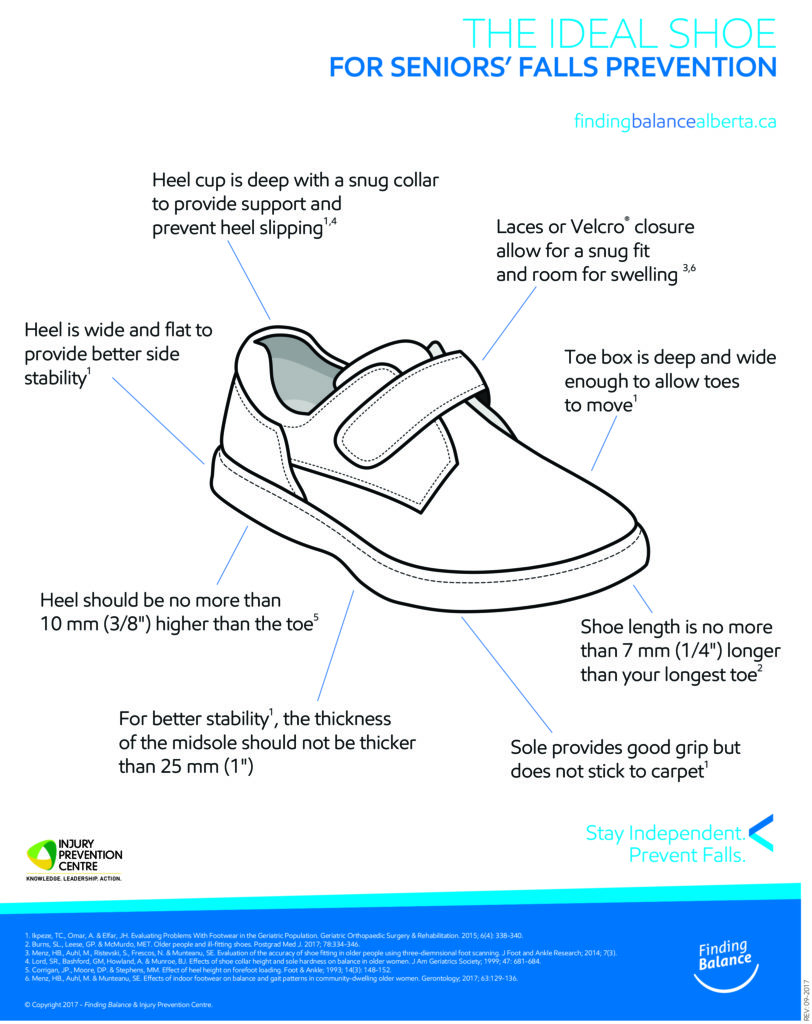
How To Get Up By Yourself After A Fall
If you have a fall:
- Lie still a minute.
- Stay calm.
- Check yourself for injuries.
- If you are not injured, use a sturdy piece of furniture to get up.
- If you are injured, call for help.
Try a Home Exercise Routine
For strength, use resistance bands, weights, or your own body weight. For balance, practice movements like:
• reaching while standing
• toe and heel raises
• stepping in different directions
• step-ups
• half-squats
Band Exercises For Older Adults
Exercising with resistance bands is a great way to build strength in all parts of your body – legs, arms, and core. Bands are portable and inexpensive. You can use them at home, outdoors, or at the gym. Building strength with bands is safe and effective and will:
- Reduce your risk for falls
- Improve your physical capabilities
- Deter some chronic diseases
Generally, increasing your strength will lessen the symptoms of aging. (Seguin et at. 2003). Almost anyone can exercise with bands. If you:
- have talked with your healthcare provider about exercising
- have been regularly doing some exercises and/or activities
- have enough strength in your hands to hold a band securely,
then you are ready to exercise with bands.
Be Active
- Adults aged 65 years and older should accumulate at least 150 minutes of moderate to vigorous intensity aerobic physical activity per week in bouts of 10 minutes or more.
- Plus, it is beneficial to add muscle and bone strengthening activities, like exercising with bands, at least 2 days per week.
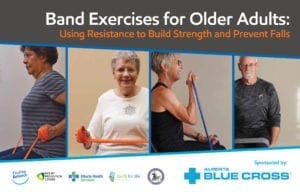
Download the Everyday Exercises For Older Adults
Other Resources from findingbalancealberta.ca
Download the Exercise Tips For Older Adults
Fall Prevention Resources
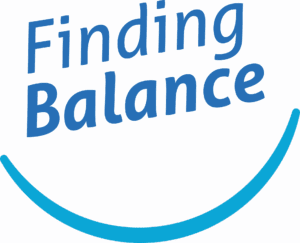
All of the information above is from the Alberta Health Services Fall Prevention initiative – Finding Balance, which is an education program and public awareness campaign created by the Injury Prevention Centre at the University of Alberta’s School of Public Health. It’s designed to help adults aged 55 and over stay independent, safe, and informed.
For more information on fall prevention, visit the findingbalancealberta.ca website
Sign up to receive their eNewsletter, as well as invitations to our webinars and other events.
